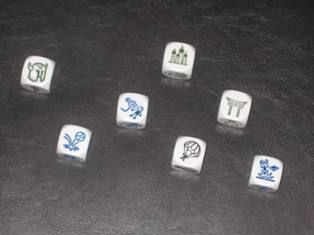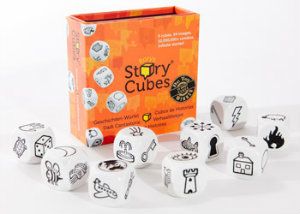Rory’s Story Cubes are a remarkably simple and effective means for inspiring creative thinking and problem solving in all of us. Simply toss all the dice, examine each of the nine face-up images and let them guide your imagination through a story that begins with “Once upon a time…”.I don't recall where I first stumbled across Rory's Story Cubes, but after reading a bit about them, I was eager to check them out, for a couple of reasons. First, my daughter loves to write and tell stories, and I knew this was right in her wheelhouse, and second, the applications to my style of campaign preparation were obvious.
The nine dice, each with an image on six sides, hold a total of 54 images. This means that with every roll, there are over 10 million combinations for you to use as the inspiration for your story. The uses for Rory’s Story Cubes are boundless. Whether it’s in a classroom or business, the process of creating and telling your own story can provide untold understanding of our language, of the world we live in and of ourselves.
The secret is not to think too deeply. Simply ‘gulp’ in the images and start talking. The story will reveal itself through the cubes and in so doing, will unleash creativity, freedom of expression and frequently, an insight to how to solve a seemingly intractable personal or business problem.
There are actually three different sets of Story Cubes: the original set, the Actions set, and the Voyages set. The nine blue-inked Actions dice icons feature little stick figures or drawings - "picto-verbs™" - of actions, while the nine green-inked Voyages dice icons represent places or travel. That's twenty-seven dice offering an astounding 1,023,490,369,077,469,249,536 possible combinations; the only real limitation is my own imagination in interpreting the various icons.
I'm been using the Story Cubes in a couple of ways: first, generating random encounters, either in conjunction with the tables contained in Flashing Blades or on their own, and second, to create events in the lives of various non-player characters whom the player characters know. They provide a means of creating a more complex backstory to an encounter than the random motivations table, and because they are geared to creating short stories, they give me a means of introducing some sort of random conflicts into the lives of their friends and allies, conflicts in which the player characters may choose to involve themselves out of loyalty, or be drawn into by virtue of a patron-client relationship. They are also very good for creating rumors.
My usual method for using the Story Cubes is to toss all twenty-seven dice into a container of some sort - in this instance, it's my son's travel-team baseball cap, left lying on the ottoman - and grab out a handful of dice. Here's my throw, and my initial free associations for each.
Helmet - armor, defense
Ball bouncing - playing tennis
Domed towers - Central Asia or Arabia
Drawing a picture - creating art
Parachutist - controlled descent, da Vinci invention?
Torii - Japan, Far East
Rocket crashing - fireworks?

So perhaps the parachute isn't metaphorical after all. Now to turn this into an encounter.
At the tennis courts (bouncing ball) at Fontainebleau, there's a spirited discussion among several players of a rake leaping from his mistress' bedroom window into a moat in order to escape her husband's guards (helmet). Someone opines that such an exit is a dicier proposition without water to break the fall (rocket crashing). Another player of the group says that a missionary with the Spanish ambassador's entourage, recently returned from Tartary (domed towers), described how dancers in the Far East (torii) leaped from high platforms with large silk parasols to break their fall. Not to be outdone, the first player relates that a secretary of the Venetian ambassador's party spoke of a marvelous invention, a canopy from which a man was suspended and could float to the ground in perfect safety (parachutist) - it's said he even has an illustration of the machine (drawing a picture). The veracity of the claims is debated, and a wager to test the theory is offered.
Perhaps the adventurers decide to follow up with the Portuguese missionary or the Dalmatian secretary, to learn more about these marvels, with an eye to some future application or even to win the wager. Maybe they ignore it all together. This encounter or rumor is what I think of as grist for the mill - it establishes facts of the game-world for the player characters, to use or not at their discretion, which in my experience is an important part of running a sandbox-style campaign. And as a bit of historical background, it's kinda fun in its own right, a small way of bringing the historical period to life for the players.
Now, this probably sounds like a butt-load of work for very little return - in fact, the whole process took me less than ten minutes, including the Google searches - but here's the thing: I would never, ever have come up with anything even remotely like this on my own. The Story Cubes lead my imagination to wholly unexpected places, which is what makes them so much fun. I'll have more on this in a later post.
Tomorrow, creating a random encounter using the Backswords & Bucklers job tables.



No comments:
Post a Comment
All comments are moderated so please be patient.